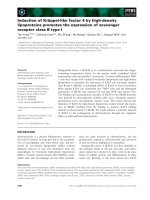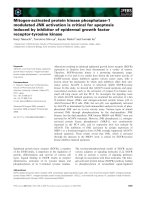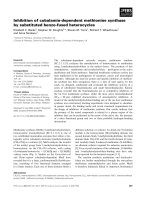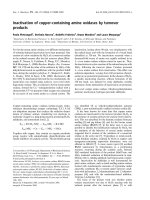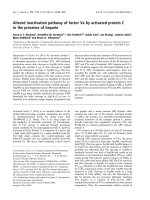báo cáo khoa học: " FCR (Fludarabine, Cyclophosphamide, Rituximab) regimen followed by 90yttrium ibritumomab tiuxetan consolidation for the treatment of relapsed grades 1 and 2 follicular lymphoma: a report of 9 cases" pot
Bạn đang xem bản rút gọn của tài liệu. Xem và tải ngay bản đầy đủ của tài liệu tại đây (251.52 KB, 5 trang )
CAS E REP O R T Open Access
FCR (Fludarabine, Cyclophosphamide, Rituximab)
regimen followed by
90
yttrium ibritumomab
tiuxetan consolidation for the treatment of
relapsed grades 1 and 2 follicular lymphoma:
a report of 9 cases
Francesco Pisani
1*
, Carlo Ludovico Maini
2
, Rosa Sciuto
2
, Laura Dessanti
1
, Mariella D’Andrea
1
, Daniela Assisi
3
,
Maria Concetta Petti
1
Abstract
Background: This retrospective analysis is focused on the efficacy and safety of radioimmunotherapy (RIT) with
Zevalin
®
in nine patients with recurrent follicular lymphoma (FL) who were treated in a consolidation setting after
having achieved complete remission or partial remission with FCR.
Methods: The median age was 63 yrs (range 46-77), all patients were relapsed with histologically confirmed CD20-
positive (grade 1 or 2) FL, at relapse they received FCR every 28 days: F (25 mg/m
2
x 3 days), C (1 gr/m
2
day 1) and
R (375 mg/m
2
day 4) for 4 cycles. Who achieved at least a partial remission, with < 25% bone marrow
involvement, was treated with
90
Yttrium Ibritumomab Tiuxetan 11.1 or 14.8 MBq/Kg up to a maximum dose 1184
MBq, at 3 months after the completion of FCR. The patients underwent a further restaging at 12 weeks after
90
Y-
RIT with total body CT scan, FDG-PET/CT and bilateral bone marrow biopsy.
Results: Nine patients have completed the treatment: FCR followed by
90
Y-RIT (6 patients at 14.8 MBq/Kg, 3
patients at 11.1 MBq/Kg). After FCR 7 patients obtained CR and 2 PR; after
90
Y-RIT two patients in PR converted to
CR 12 weeks later. With median follow up of 34 months (range 13-50) the current analysis has shown that overall
survival (OS) is 89% at 2 years, 76% at 3 years and 61% at 4 years. The most common grade 3 or 4 adverse events
were hematologic, one patient developed herpes zoster infection after 8 months following valacyclovir
discontinuation; another patient developed fungal infection.
Conclusions: Our experience indicate feasibility, tolerability and efficacy of FCR regimen followed by
90
Y-RIT in
patients relapsed with grades 1 and 2 FL with no unexpected toxicities. A longer follow up and a larger number of
patients with relapsed grades 1 and 2 FL are required to determine the impact of this regimen on long-term
duration of response and PFS.
Background
Follicular lymphoma is the most common type of indo-
lent non-hodgkin lymphoma (NHL) in Western coun-
tries and is typically characterized by rec urrence of
disease. There is usually a pattern of repeated remissions
and relapses until patients become refractory to treat-
ment. The duration of remissions becomes shorter with
repeated induction a ttempts. Transformation to more
aggressive NHL occurs in 15% to 50% of the patients at
5 years.After first relapse patients in otherwise good
health are candidate for salvage chemotherapy: combina-
tion chemotherapy, immunotherapy, and for some
patients with good performance status and responsive
disease, myeloablative therapy with stem-cell rescue.
* Correspondence:
1
Department of Hematology Regina Elena National Cancer Institute, Via Elio
Chianesi, 53 00128 Rome, Italy
Full list of author information is available at the end of the article
Pisani et al . Journal of Experimental & Clinical Cancer Research 2011, 30:16
/>© 2011 Pisani et al; licensee BioMed Central Ltd. This is an Open Access article distributed under the terms of the Creative Commons
Attribution License ( which permits unrestricted use, distribution, and reproduct ion in
any medium, provided the original work is properly cited.
A number of cytotoxic agents in combination are active in
this patient population and FCR regimen has provided
encouraging results as initial or salvage therapy in patients
with CLL or indol ent NHL [1,2]. Radioimmunotherapy is
also a n excellent m odality in t he treatment of NHL; the tar-
get antigen, radionuclide emission propertie s, and chemical
stability of radioimmunoconjugates are important factors
that contribute to the effectiveness of RIT.
90
Yttrium can
deliverahighbetaenergytotumor(2-3MeV)and
90
Yttrium Ibritumomab Tiuxetan (
90
Y -RIT ) - Zevalin
®
-
consists of the anti-CD20 monoclonal antibody ibritumo-
mab (an IgG1k antibody which is the murine parent immu-
noglobulin to rituximab) covalently bound to the chelating
agent tiuxetan and radiolabeled with
90
Yttrium.
Furthermore recently FIT study has shown that conso-
lidation of first remission with
90
Yttrium in advance-
stage follicular lymphoma is highly effective with no
unexpected toxicities, prolonging progression free survi-
val (PFS) by 2 years [3,4]. Then consolidation with
90
Yttrium after first line induction therapy, may allow
more patients, with disseminated disease at diagnosis, to
benefit from radioimmunotherapy and may present an
attracti ve treatment option, particu lary in older patients
(age ≥ 60 years) who represent rougly 50% of patients
with newly diagnosed indolent NHL.
90
Y-RIT also has been reported to be effective in
patients with relapsed or refractory FL [5-7]. In this arti-
cle we describe our experience with
90
Y-RITconsoli-
dation in nine patients relapsed with grade 1 and 2 FL
patients, responding to FCR.
Methods
Patients
The patients who were included in the current retrospec-
tive analysis had CD20+ histologically confirmed relapsed
grade 1 or 2 follicular lymphoma, all patients provided
informed consent according to institutional guidelines.
Patients had received at le ast one prior treatme nt, were
age ≥ 18 years, with WHO performance status of 0 to 2,
hadachievedatleastPRatthecompletionofFCR;the
last chemotherapy with or without rituximab was admi-
nistered at least three months before start of FCR; no
patient under maintenance therapy with rituximab was
considered. Patients had less than 25% bone marrow
involvement by lymphoma on biopsy before start of RIT;
an absolute neutrophil count ≥ 1.5 × 10
9
L; hemoglobin
levels ≥ 9 gr/dl and a platelet count ≥ 100 × 10
9
L.
Patients with central nervous system (CNS) involvement,
positive HIV were excluded from the analysis.
Treatment
Patients at relapse had received 4 cycles of FCR: fludara-
bine at a dose of 25 mg/m
2
i.v. on days 1 to 3; cyclopho-
sphamide at a dose of 1 gr/m
2
i.v. on day 1 and rituximab
at a dose of 375 mg/m
2
was given on day 4 of each cycle
every 28 days. Patients were restaged with CT scan, FDG
PET/CT and bone marrow biopsies after the last course
of FCR: who had achieved at least a partial remission,
with < 25% bone marrow involvement, received 12 weeks
since the last course of FCR two infusions of rituximab
250 mg/m
2
one week apart, with the first infusion admi-
nistered alone and the second infusion followed immedi-
ately by
90
Y-RIT 14.8 MBq/Kg - 11 MBq/Kg, if the
platelet number was between 100 × 10
9
/L and 149 × 10
9
/
L, not to exceed a total of 1.184 MBq administered as a
slow i.v. push over 10 minutes (Figure 1).
Assessments
All patients included in the analysis were restaged with
CT scan, FDG-PET and bilateral bone marrow biopy at
4-5 weeks after the l ast cycle of FCR and 12 weeks after
90
Y-RIT. No real-time quantitative PCR (RQ-PCR) eva-
luation of pheripheral or ma rrow blood samples for bcl-
2 t(14;18) translocation was performed at baseline and
thereafter. Safety was assessed by adverse events (AEs),
with toxicity grading based on the National Cancer
Institute Common Toxicity Criteria (version 2), clinical
laboratory evaluations, and physical examinations. OS
was calculated from the date of FCR treatment to the
date of death from any cause; OS was analyzed by using
the Kaplan-Meier method.
Results
Patients characteristics
In this retrospective analysis, from August 2005 to July
2010, 9 patients had received FCR 4 cycles followed by
90
Y-RIT(6patientsat14.8MBq/Kg,3patientsat11.1
MBq/Kg). Baseline characteristics are presented in
(Table 1). The median age was 63 years (range 46-77 ).
All patients were relapsed patients: 2 pati ents received a
prior therapy, 5 patients received 2 prior treatments and
2 patients had received 3 regimens. Seven patients were
previously treated with rituximab plus chemotherapy,
two patients had no previous rituximab treatment his-
tory, one patient received also high-dose therapy fol-
lowed by autologous stem cell transplantation (Table 2)
F: 25 mg/m
2
i.v days 1-3
C: 1gr/m
2
i.v day 1
R: 375mg/m
2
i.v day 4
FCR-28
4 CYCLES
Zevalin
®
11.1-14.8
MBq/Kg
CR/CRu
or PR
Restage before RIT:
CT, PET, BMB
Restage 12 weeks
After Zevalin®
CT, PET, BMB
Figure 1 Treatment schema.
Pisani et al . Journal of Experimental & Clinical Cancer Research 2011, 30:16
/>Page 2 of 5
Efficacy and safety
After 4 cycles FCR seven patients obtained CR and
2 PR, two patients in PR converted to CR after RIT.
With a median observation period of 34 months (range
13- 50) the OS is 89% at 2 years, 76% at 3 years a nd
61% at 4 years. Grade 3 or 4 neutropenia occurred in 8/
9 pati ents treated with FCR and in 9/9 patients assess a-
ble after
90
Y-RIT. Subsequently to radioimmunotherapy
the median neutrophil nadir was 0.8 × 10
9
/L (range
0.1-0.9 × 10
9
/L) at we ek 5, the median platelet count
nadir was 49 × 10
9
/L (range 17-80 × 10
9
/L) at week 5.
The median duration nadir for both neutrophils or pla-
telets was 14 days. One patient developed herpes zoster
infection a fter 8 months following valacyclovir disconti-
nuation; another patient developed fungal infection.
Both infections disappeared after specific treatment.
After a median observation period of 34 months one
patient developed t-MDS (treatment-related myelodys-
plastic syndrome) at 26 months after
90
Y-RIT. This
patient before FCR and consolidation with RIT had
received three previous regimens: at diagnosis 6 courses
of CHOP, at first relapse, 3 years later, four courses of
FM/R (fludarabine, mitoxantrone plus rituximab) and
after one year, at the second relapse, he received cyclo-
phosphamide plus dexamethasone and rituximab,
remaining in CR for 48 months. He died at 73 years of
age for sepsis during support therapy for t-MDS. Ot her
two patients have died: one for acute renal failure and
one for ictus cerebri.
Discussion
In follicular lymphoma retreatment typically yields pro-
gressively less satisfactory responses than the prior treat-
ment, eventually leading to refractory disease, and the
question remains regarding whether the survival of
patients with FL is improving with new treatment
regimens.
In the current retrospective analysis, nine patients
with relapsed grade 1 and 2 FL, responding to FCR regi-
men and consolidated with
90
Y-RIT obtained a signifi-
cant high rate of response with 100% of CR and
acceptable toxicity. After a median observation period of
34 months 6/9 patients were alive in CR and 7/9 were
already treated with at least two prior regimens. Two
patients converted PR to CR after consolidation with
90
Y-RIT. This conversion was already shown in published
phase III study (FIT-study) in first-line FL [3,4], and in
previous phase II studies of consolidation with the
radioimmunotherapy agent
131
I-tositumomab after first-
line induction [8,9],
Table 1 Patient characteristics
Number of patients = 9
Male/Female 3/6
Median Age (Range) 63 (46-77) years
Disease stage at diagnosis at start of FCR
I10
II 1 5
III 1 3
IV 6 1
Bone marrow involvement
0% 7
10% to ≤ 25% 2
Extranodal involvement 1 (liver)
FLIPI
Low 1
Low-intermediate 6
Intermediate-high 2
Bulky disease 1
B-symptoms 0
Prior therapy including rituximab
No 2
Yes 7
Number of previous regimens
12
25
>2 2
Table 2 Clinical characteristics
Patients No Sex/Age (y) Previous treatment Response to FCR Response to RIT Follow up (mo) since RIT
1 F/68 CHOP/R, radiotherapy CR CR 50 alive in CR
2 F/66 Radiotherapy, CHOP/R CR CR 34 alive in CR
3 F/57 CHOP/R PR CR 44 alive in CR
4 F/67 CHOP/R, radiotherapy CR CR 13 dead in CR
5 M/46 CHOP/like, ASCT, IFN maintenance for 24 months PR CR 28 alive in CR
6 F/61 MACOPB/R CR CR 39 alive in CR
7 M/69 CHOP,FM/R, Cy Dex/R CR CR 30 dead in CR
8 M/57 Chlorambucil, MACOPB/R CR CR (t-MDS) 32 dead in CR
9 F/77 Chlorambucil, radiotherapy CR CR 44 alive in CR
CHOP: cyclophosfamide, doxorubicin, vincristine, prednisone; R: Rituximab; MACOPB: Methotrexate, Doxorubicin, cyclophoshamide, vincristine, prednisone,
bleomycin,; ASCT: autologous stem cell transplantation; IFN: alpha interferon, FM: flud arabine, mitoxantrone; Cy Dex: cyclophosphamide, dexamethasone; t-MDS:
treatment-related myelodysplastic syndrome.
Pisani et al . Journal of Experimental & Clinical Cancer Research 2011, 30:16
/>Page 3 of 5
confirming the ability of
90
Y-RIT to improve
responses also in patients who are pretreated with ritux-
imab based combination therapy [3]; even if in our two
patients there is no proof that this conversion was due
to RIT and not to a late response to FCR. In the FIT
study close to 17% of the patients in the control arm,
converted from PR to CR during watchful waiting [3],
butitistobeconsideredthatourtwopatientshad
higher risk of resistance being already pretreated.
In our analysis the OS at 2 years was 89%, at 3 years
76% and at 4 years 61%. In another study conducted on
patients with recu rrent FL, treated with FCR, a 75% OS
rate at 4 years and a 61% PFS rate at 4 years were regis-
tered, but in that study only 7% of patients had been
treated previously with rituximab and furthermore no
patients had received combination treatment with che-
motherapy plus rituximab [10]. Regarding AEs there was
a high incidence of neutropenia and thrombocytopenia
but hematologic toxicities grade 3 or 4 did not require
transfusion but growth factor support was utilized in
the majority of patients during FCR treatment, and in
all of them after
90
Y-RIT. Despite the high incidence of
grade 3 or 4 neutropenia there were no patients requ ir-
ing hospitalization for infection. We registered a case of
herpes zoster infection after 8 months following valacy-
clovir discontinuation that disappeared after retreat-
ment, and a case of fungal infection by conidiobolus,
developed 10 months after
90
Y-RIT and disappeared
with itraconazole treatment. Other previous studies have
already shown the low percentage of patients requiring
hospitalization for infections [3,5] and a favorable safety
profile [11,12]. A case of t-MDS with complex karyotype
was diagnosed 26 months after
90
Y-RIT consolidation:
this patient received 3 previous regimens before FCR
plus
90
Y-RIT, as already mentioned he died for sepsis.
This patient had been previously treated with topoi-
somerase II inhibitors, alkylating agents and purine
nucleoside analogs. Czuczman et al. reported an inci-
dence of t-MDS and t-AML (treatment-related acute
myeloid leukemia) a fter
90
Y-RIT of 0.3% per year after
the diagnosis of NHL and 0.7% per year after treatment.
Most patients with t-MDS or t-AML had multiple cyto-
genetic aberrations, commonly on c hromosomes 5 and
7, suggesting an association with previous exposure to
chemotherapy. In Czuczman study these malignanc ies
were diagnosed at a median of 5.6 years (range 1.4 to
13.9) after the diagnosis of NHL and 1.9 years (range
0.4 to 6.3) after radioimmunotherapy [13]; the conclu-
sion of this study was that the annualized incidences of
t-MDS and t-AML were consistent with that expected
in patients with NHL who have had extensive previous
chemotherapy and do not appeared to be increased after
90
Y-RIT. Cytogenet ic testing before treatment with RIT
may identify existing chromosomal abnormalities in
previously treated patients, particularly those who have
been treated w ith alkylating agents and purine analogs
and would be at higher risk to develop t-MDS or
t-AML.
In our series the other two death were not in relation
of progressive disease and all three deceased patients
obtained CR before
90
Y-RIT and died still in CR.
Additional follow up is required to determine potential
long-term AEs with
90
Y-RIT conso lidation. In our
patients, the response to
90
Y-RIT was assessed by CT,
bone marrow biopsies and also with FDG-PET, this ima-
ging procedure is useful to evaluate disease extension
before treatment and response to RIT in FL. A recent
study has shown that the post-RIT PET result is an
independent predictive factor of PFS [14].
Conclusions
This retrospective analysisofninerelapsedgrades1or
2 FL patients with median age 63 years, heavily pretreated,
demonstrates that FCR followed by
90
Y-RIT was feasible,
safe and yielded high overall and complete response rates
in patients with recurrent FL. Hematologic toxicity
occurring with FCR or with RIT were clinically controlla-
ble and accep table i n a population composed mainly of
patients with a history of prior treatment using rituximab
plus chemotherapy. A longer follow up and a larger
number of patients with relapse d grades 1 and 2 FL are
required to determine the impact of this regimen on
long-term duration of respons e and PFS, but this preli-
minary results suggest that this regimen could be an
option to be used for the treatment in this setting of
patients, specially at age of 60-75 and earlier in first
relapse; further studies will help to clarify the best strat-
egy for incorp orating R IT into the treatment algorithm
of these patients.
Abbreviations
FCR: fludarabine cyclophosphamide rituximab; FL: follicular lymphoma; NHL:
non hodgkin lymphoma; RIT: radioimmunotherapy; MeV: megaelectronvolt;
MBq: megabecquerel; OS: overall survival; PFS: progre ssion free survival; t-
MDS: treatment related myelodisplastic syndrome.
Acknowledgements
The authors thank Dr. Diana Giannarelli of the Department of Oncology
Regina Elena National Cancer Institute for statistical analysis.
Author details
1
Department of Hematology Regina Elena National Cancer Institute, Via Elio
Chianesi, 53 00128 Rome, Italy.
2
Department of Nuclear Medicine Regina
Elena National Cancer Institute, Rome, Italy.
3
Department of
Gastroenterology Regina Elena National Cancer Institute, Rome, Italy.
Authors’ contributions
Conception and design: FP, wrote the paper
Provision of study materials or patients: FP, MCP, CLM, RS, LD, MD, DA
All authors have read and approved the final manuscript.
Competing interests
The authors declare that they have no competing interests.
Pisani et al . Journal of Experimental & Clinical Cancer Research 2011, 30:16
/>Page 4 of 5
Received: 30 September 2010 Accepted: 8 February 2011
Published: 8 February 2011
References
1. Tam CS, Wolf M, Prince HM, Januszewicz EH, Westerman D, Lin IK,
Carney D, Seymour JF: Fludarabine, Cyclophosphamide, and Rituximab
for the treatment of patients with chronic lymphocytic leukemia or
indolent non-Hodgkin’s lymphoma. Cancer 2006, 106:2412-2420.
2. Czuczman MS, Koryzna A, Mohr A, Stewart C, Danohue K, Blumenson L,
Bemstein ZP, McCarthy P, Alam A, Hernandez-Ilizaliturri F, Skipper M,
Brown K, Chanan-Khan A, Klippestein D, Loud P, Rock MK, Benyunes M,
Grillo-Lopez A, Bemstein SH: Rituximab in combination with fludarabine
chemotherapy in low-grade or follicular lymphoma. J Clin Oncol 2005,
23:694-704.
3. Morschhauser F, Radford J, Van Hoof A, Vitolo U, Soubeyran P, Tilly H,
Huijgens PL, Kolstad A, d’Amore F, Diaz MG, Petrini M, Sebban C,
Zinzani PL, van Oers MHJ, van Putten W, Bischof-Delaloye A, Rohatiner A,
Salles G, Kuhlmann J, Hagenbeek A: Phase III trial of consolidation therapy
with Yttrium-90-Ibritumomab tiuxetan compared with no additional
therapy after first remission in advanced follicular lymphoma. J Clin
Oncol 2008, 26:5156-5164.
4. Morschhauser F, Dreyling M, Rohatiner A, Hagemeister F, Bischof-
Delaloye A: Rationale for consolidation to improve progression-free
survival in patients with non-Hodgkin’s lymphoma: A review of the
evidence. The Oncologist 2009, 14:17-29.
5. Witzing TE, White CA, Gordon LI, Wiseman GA, Emmanouilides C, Murray JL,
Lister J, Multani PS: Safety of Yttrium-90 ibritumomab tiuxetan
radioimmunotherapy for relapsed low-grade, follicular, or transformed
non-Hodgkin’s lymphoma. J Clin Oncol 2003, 21:1263-1270.
6. Emmanouilides C, Witzing TE, Gordon LI, Vo K, Wiseman GA, Flinn IW,
Darif M, Schilder RJ, Molina A: Treatment with Yttrium-90 ibritumomab
tiuxetan at early relapse is safe and effective in patients with previously
treated B-cell non-Hodgkin’s lymphoma. Leuk Lymphoma 2006,
47:629-636.
7. Witzing TE, Molina A, Gordon LI, Emmanouilides C, Schilder RJ, Flinn IW,
Darif M, Macklis R, Vo K, Wiseman GA: Long-term responses in patients
with recurring or refractory B-cell non-Hodgkin’s lymphoma treated with
Yttrium-90 ibritumomab tiuxetan. Cancer 2007, 109:1804-1810.
8. Leonard JP, Coleman M, Kostakoglu L, Chadbum A, Cesarman E, Furman RR,
Schuster MW, Niesvizky R, Muss D, Fiore J, Kroll S, Tidmarsh G,
Vallabhajosula S, Goldsmith SJ: Abbreviated chemotherapy with
fludarabine followed by tositumomab and iodine I-131-tositumomab for
untreated follicular lymphoma. J Clin Oncol 2005, 23:5696-5704.
9. Press OW, Unger JM, Braziel RM, Maloney DG, Miller TP, Leblanc M,
Fisher RI: Phase II trial of CHOP chemotherapy followed by I-131-
tositumomab for previously untreated follicular non-Hodgkin’s
lymphoma: Five years follow up of Southwest Oncology Group Protocol
59911. J Clin Oncol 2006, 24:4143-4129.
10. Sacchi S, Pozzi S, Marcheselli R, Federico M, Tucci A, Merli F, Orsucci L,
Liberati M, Vallisa D, Brugiatelli M: Rituximab in combination with
fludarabine and cyclophosphamide in the treatment of patients with
recurrent follicular lymphoma. Cancer 2007, 110
:121-128.
11. Dreyling M, Trumper L, von Schilling C, Rummel M, Holtkamp U,
Waldmann A, Wehmeyer J, Freund M: Results of a national consensus
workshop: therapeutic algorithm in patients with follicular lymphoma -
Role of radioimmunotherapy. Ann Hematol 2007, 86:81-87.
12. Zinzani PL, d’Amore F, Bombardieri E, Brammer E, Codina JG, Ilidge T,
Jurczak W, Linkesch W, Morschhauser F, Vandenberghe E, Van Hoof A:
Consensus conference: Implementing treatment recommendations on
Yttrium-90 immunotherapy in clinical practice - Report of a European
workshop. Eur J Cancer 2008, 44:366-373.
13. Czuczman MS, Emmanoulides C, Darif M, Witzig TE, Gordon LI, Revell S,
Vo K, Molina A: Treatment-related myelodysplastic syndrome and acute
myelogenous leukaemia in patients treated with ibritumomab tiuxetan
radioimmunotherapy. J Clin Oncol 2007, 25:4285-4292.
14. Lopci E, Santi I, Derenzini E, Fonti C, Savelli G, Bertagna F, Bellò M, Botto M,
Huglo D, Morschhauser F, Zinzani PL, Fanti S: FDG-PET in the assessment
of patients with follicular lymphoma treated by ibritumomab tiuxetan Y-
90: multicentric study. Ann Oncol 2010, 21:1877-1883.
doi:10.1186/1756-9966-30-16
Cite this article as: Pisani et al.: FCR (Fludarabine, Cyclophosphamide,
Rituximab) regimen followed by
90
yttrium ibritumomab tiuxetan
consolidation for the treatment of relapsed grades 1 and 2 follicular
lymphoma: a report of 9 cases. Journal of Experimental & Clinical Cancer
Research 2011 30:16.
Submit your next manuscript to BioMed Central
and take full advantage of:
• Convenient online submission
• Thorough peer review
• No space constraints or color figure charges
• Immediate publication on acceptance
• Inclusion in PubMed, CAS, Scopus and Google Scholar
• Research which is freely available for redistribution
Submit your manuscript at
www.biomedcentral.com/submit
Pisani et al . Journal of Experimental & Clinical Cancer Research 2011, 30:16
/>Page 5 of 5


